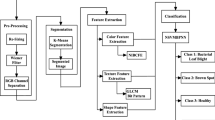Abstract
Automated disease detection using the features of infected regions of a diseased plant image is a growing field of research in precision agriculture. Usually, infected regions are identified by applying different threshold based segmentation techniques. However, due to various factors like non-uniform illumination or noises, these techniques fail to provide sufficient information for classifying diseases accurately. In the paper, a novel region identification method based on Fermi energy has been proposed to detect the infected portion of the diseased rice images. From the infected region, neighboring gray level dependence matrix (NGLDM) based texture features are extracted to classify different diseases of rice plants. Performance of the proposed method has been evaluated by comparing classification accuracy with other segmentation algorithms, demonstrating superior result.
Access this chapter
Tax calculation will be finalised at checkout
Purchases are for personal use only
Preview
Unable to display preview. Download preview PDF.
Similar content being viewed by others
References
Sing, A.K.: Advances in Data Analytical Techniques, vol. VI, pp. 165–174. Indian Agricultural Statistics Research Institute
Ray, N., Saha, B.N.: Edge Sensitive Variational Image Thresholding. In: ICIP, vol. VI, pp. 37–40 (2007)
Gonzalez, R.C., Woods, R.E.: Digital Image Processing. Pearson Education, New Delhi (2007)
Sankur, B., Sezgin, M.: Survey over image thresholding techniques and quantitative performance evaluation. Electron Imaging 13(1), 146–165 (2004)
Trier, O.D., Jain, A.K.: Goal-directed evaluation of binarization methods. IEEE Tran. Pattern Analysis and Machine Intelligence PAMI-17, 1191–1201 (1995)
Guo, R., Pandit, S.M.: Automatic threshold selection based on histogram modes and a discriminant criterion. Machine Vision and Applications 10, 331–338 (1998)
Cai, J., Liu, Z.Q.: A New Thresholding Algorithm Based on All-Pole Model. In: ICPR 1998, Int. Conf. on Pattern Recognition, Australia, pp. 34–36 (1998)
Cho, S., Haralick, R., Yi, S.: Improvement of Kittler and Illingworths’s Minimum Error Thresholding. Pattern Recognition 22, 609–617 (1989)
Jawahar, C.V., Biswas, P.K., Ray, A.K.: Investigations on fuzzy thresholding based on fuzzy clustering. Pattern Recognition 30(10), 1605–1613 (1997)
Li, C.H., Tam, P.K.S.: An Iterative Algorithm for Minimum Cross-Entropy Thresholding. Pattern Recognition Letters 19, 771–776 (1998)
Savakis, A.: Adaptive document image thresholding using foreground and background clustering. In: ICIP 1998: Int. Conf. On Image Processing, Chicago (October 1998)
Cheng, S.C., Tsai, W.H.: A Neural Network Approach of the Moment-Preserving Technique and Its Application to Thresholding. IEEE Trans. Computers (42), 501–507 (1993)
Kass, M., Witkin, A., Terzopoulos, D.: Snakes: Active contour models: IJCV, pp. 321–331 (1987)
Caselles, V., Kimme, R.: Minimal Surfaces Based Object Segmentation. IEEE Transactions on Pattern Analysis and Machine Intelligence 19(4), 394–398 (1997)
Xavier, B., Pierre, V., Jean-Philippe, T.: A priori information in image segmentation: energy functionalbased oh’ shape statistical model and image information. IEEE (2003)
Hummel, R.E.: Electronic Properties of Materials (6), 63–74 (2011)
Wei, G., Sammes, N.M.: An introduction to electronic and ionic materials (3), 41–44 (2000)
Chaoxin, Z., Da-Wen, S., Liyun, Z.: Recent applications of image texture for evaluation of food qualities—a review. Trends in Food Science & Technology 17, 113–128 (2006)
Otsu, N.: A Threshold Selection Method from Gray Level Histograms. IEEE Transaction on Systems, Man and Cybernetics 9, 62–66 (1979)
MacQueen, J.B.: Some Methods for classification and Analysis of Multivariate Observations. In: Proceedings of 5th Berkeley Symposium on Mathematical Statistics and Probability, pp. 281–297. University of California Press (1967)
WEKA, Machine Learning Software (2011), http://www.cs.waikato.ac.nz/~ml/
Ou, S.H.: Rice Diseases,England: Commonwealth Mycological Institute (1972)
Webster, R.K.: Rice blast disease identification guide. University of California, Davis (2000)
Rice Doctor, International Rice Research Institute, Philipines (2003), http://www.irri.org
Author information
Authors and Affiliations
Editor information
Editors and Affiliations
Rights and permissions
Copyright information
© 2013 Springer-Verlag Berlin Heidelberg
About this paper
Cite this paper
Phadikar, S., Sil, J., KumarDas, A. (2013). Region Identification of Infected Rice Images Using the Concept of Fermi Energy. In: Meghanathan, N., Nagamalai, D., Chaki, N. (eds) Advances in Computing and Information Technology. Advances in Intelligent Systems and Computing, vol 177. Springer, Berlin, Heidelberg. https://doi.org/10.1007/978-3-642-31552-7_82
Download citation
DOI: https://doi.org/10.1007/978-3-642-31552-7_82
Publisher Name: Springer, Berlin, Heidelberg
Print ISBN: 978-3-642-31551-0
Online ISBN: 978-3-642-31552-7
eBook Packages: EngineeringEngineering (R0)




